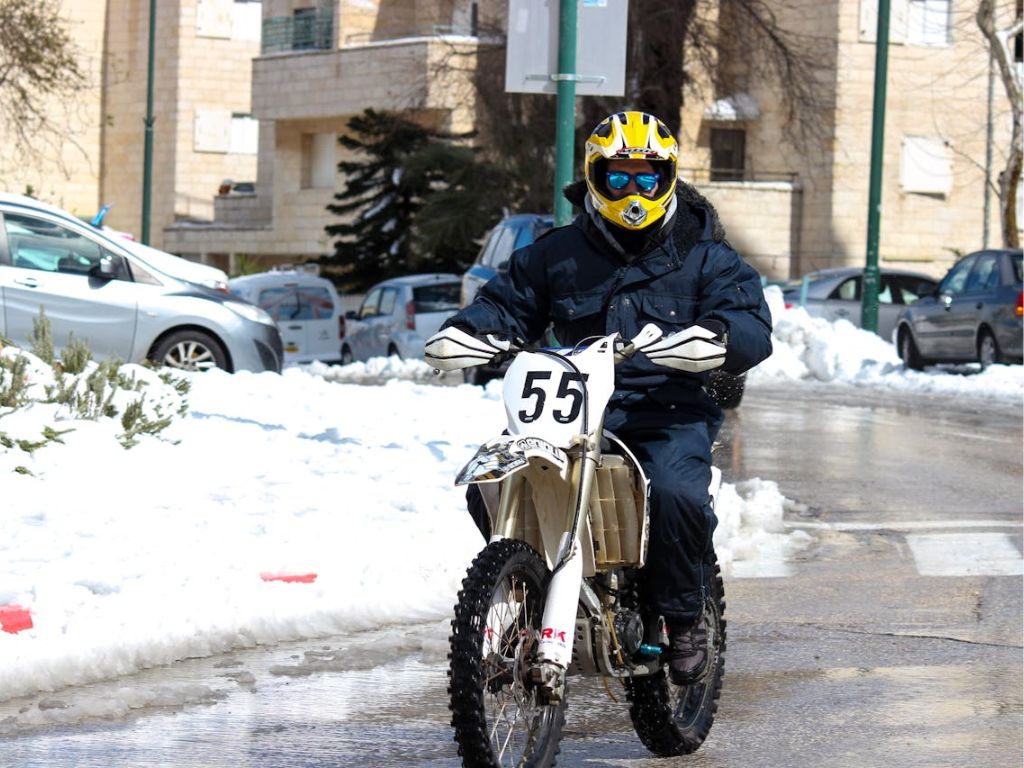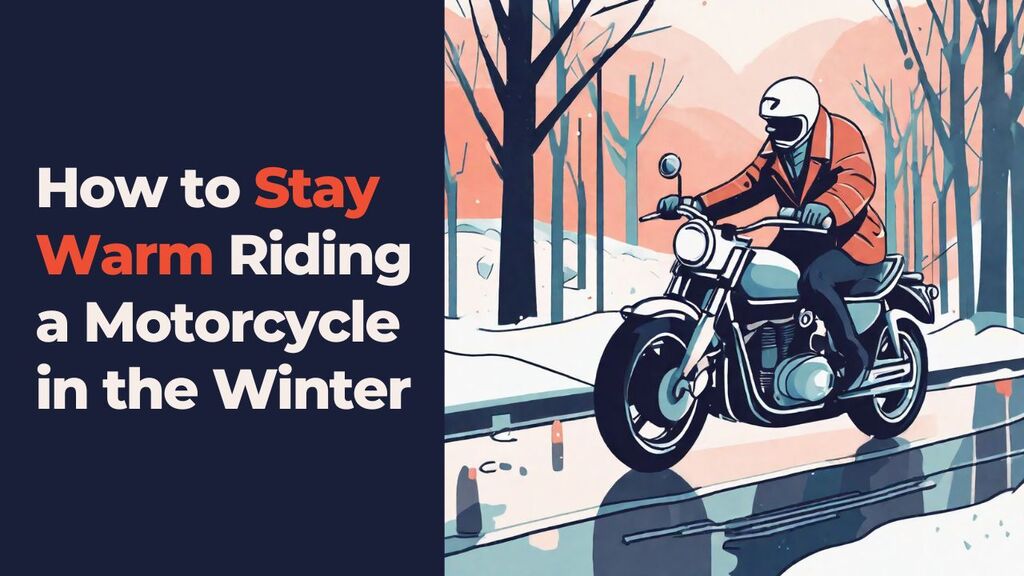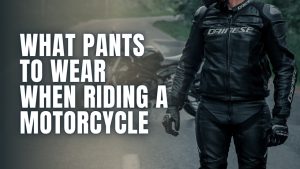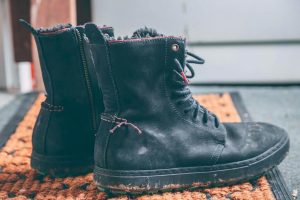Dreading winter motorcycle rides? Don’t let the cold steal your joy!
This guide equips you with the knowledge of how to stay warm riding a motorcycle in the winter. We’ll break down essential layering techniques, windproofing strategies, and heated gear options to keep you toasty warm all season long.
Forget shivering and focus on the ride – comfort and, more importantly, safety await! So, gear up and get ready to experience winter riding like never before.
Some of the links in this post are affiliate links, meaning we may get a small commission when you purchase through our links, at no extra cost to you. It helps us covering the expenses of keeping this site free for you. Thank you for your support!
How to Stay Warm Riding a Motorcycle in the Winter
To stay warm when riding in winter, you must layer up yourself from head to toe. We’ve suggested the kind of clothes and gear you should use during a cold weather ride.
Winter Motorcycle Layering Comparison Chart
| Layer | Material Options | Purpose | Benefits | Drawbacks | Best For |
|---|---|---|---|---|---|
| Base Layer | Merino Wool, Synthetic (Polyester, Nylon) | Wicks moisture & regulates temperature | + Breathable & comfortable + Odor-resistant (Merino wool) |
– Thin & delicate | Works in various conditions |
| Mid Layer | Fleece, Primaloft, Down, Wool | Traps warm air for insulation | + Different materials provide different levels of warmth | – Bulkier than base layer – Can restrict movement |
Adjust thickness based on weather |
| Outer Shell | Waterproof, Windproof Material (Gore-Tex common) | Blocks wind chill & weather elements | + Windproof & waterproof + Breathable (allows sweat to escape) |
– Can be expensive – Less breathable than some mid layers |
Keeps you dry & shields from wind chill |
1. Base Layers for Winter Riding
When it comes to staying warm on the bike, we always start with the base layer. This first layer worn next to your skin needs to keep you dry and regulate your body temperature.
Cotton, as we all know, is a big no-no for motorcycle gear. Once cotton gets wet, it stays wet. And wet cotton will suck the heat right out of your body. Not what we want on a cold winter ride!
Instead, look for a synthetic or merino wool base layer. These materials wick moisture away from your skin and breathe extremely well. Even if you work up a sweat, the moisture gets wicked to the surface where it can evaporate. Your base layer stays dry against your skin.
We’re huge fans of merino wool for motorcycle base layers. Merino is soft, comfortable and naturally odor resistant – handy when you’re wearing it for hours on end! It provides excellent insulation, trapping your body heat close to your skin. And it maintains these magical properties even when wet.
For winter riding, look for a lightweight merino piece in the 150-200 gram weight range. Any heavier and you may overheat. Going super lightweight helps regulate your temp.
Merino Wool Long Sleeve Thermal Shirts

Merino Wool Thermal Underwear Long Johns

Synthetics like polyester or nylon work well too. Just avoid anything cheap that could make you clammy. And stay far away from cotton!
A good merino or synthetic base layer is essential as your foundation. It keeps you dry and comfortable, optimizing your natural warmth. Plus it allows your mid and outer layers to work more effectively.
Now let’s talk about those mid layers and how to use them strategically with your base….
2. Mid Layers for Winter Riding
Now that we’ve got a solid base layer, let’s talk mid layers. This is where the real magic of layering comes into play.
The key is to create air gaps between your base layer and mid layer. It’s in these air pockets that your natural body heat gets trapped, keeping you insulated.
Adding a mid layer also allows you to better regulate your temperature. Got too hot? Shed the mid layer for a while. Feeling a chill? Throw it back on. Versatility is the name of the game.
For mid layer materials, you’ve got lots of excellent options:
- Fleece – Tried and true fleece is warm, breathable and lightweight. It makes a great active mid layer that wicks moisture. Easy to toss on or take off.
- Primaloft – This synthetic insulation mimics down feathers. It’s highly compressible and maintains warmth even when wet. A great option for a lightweight, packable mid layer.
- Down – Nothing beats real goose or duck down for sheer warmth and comfort. The only catch is if it gets wet, you lose all insulation. Save down for dry days.
- Wool – Merino wool makes a fantastic mid layer, providing warmth and odor control. Combine it with a merino base layer for dual woolly warmth!
The thickness of your mid layer will depend on the conditions. For cold winter riding, consider a heavier fleece or thick wool jumper. On crisp fall days, a lightweight down vest could do the trick.
32 Degrees Heat Mens Lightweight Down Alternative Vest

- 100% Nylon shell
- Insulation and lining
- Approximately 90 GSM fabric weight
Mix and match your mid layers depending on the weather to create the ideal air gaps for keeping you nice and toasty. With the right combo, you’ll stay comfy and protected from the elements.
Now, let’s move on to the all-important outer shell layer….
3. Outer Shell Clothing for Winter Riding
The outermost layer is absolutely critical for blocking wind chill and keeping you warm. We cannot emphasize enough the importance of a windproof and waterproof outer shell.
Let’s talk wind chill. Essentially, wind chill is the air movement that carries heat away from your body. The faster you ride, the greater the wind chill effect.
For example, even if the actual air temp is a mild 50°F, at 70mph that’ll feel like 30°F wind chill. Without protection, you’ll get mighty cold mighty quick.
Enter the windproof, waterproof outer shell. This layer acts like a magical force field, blocking the wind from penetrating your layers.
Modern motorcycle jackets use a waterproof, breathable membrane like GoreTex to achieve this wind blocking superpower. The membrane stops wind dead in its tracks while allowing sweat vapor to escape.

Trust us, even on a dry day, having a quality 3-layer jacket with a waterproof membrane will make a huge difference in warmth. Wind chill is no joke!
Now, for extra insurance against cold, we recommend stashing an extra windproof layer in your gear bag. This could be something as simple as a lightweight windbreaker or emergency rain jacket.
If you really start to feel the chill on a long ride, you can quickly throw on this extra wind barrier mid-journey. It provides supplementary armor against wind penetration.
With a solid waterproof, breathable outer shell, plus an extra wind layer, you’ll be prepared to battle cold winds and stay toasty warm.
4. Covering Hands and Feet During Winter Riding
Hands and feet are prone to freezing first, so protecting them is a top priority.
Starting with our paws, the best way to stay toasty is heated grips. They deliver constant, glorious warmth right to your frozen phalanges. For real cold days, crank them up to high heat.
If your bike didn’t come equipped, look into getting a heated grip kit installed. It’s one of the best cold weather upgrades around.
For additional hand protection, upgrade your regular gloves to heavyweight winter gauntlets. Look for models with extra insulation and coverage.
You could even do the whole mittens thing for maximum warmth. Sure, mittens look goofy but your hands will thank you!
Now for the feetsies. Squishing your piggies into a pair of wool socks acts like a warm hug. Merino wool is best for moisture wicking.
Darn Tough Men’s Merino Wool Cushion Socks

- A performance fit
- Don’t slip at all
- Fine gauge knitting
Then, slip your woolie-wrapped feet into a pair of sturdy, waterproof boots. The waterproofing prevents dreaded wet socks syndrome.
Some hardcore riders even opt for electric heated insoles for the ultimate in toasty toes. Slip them under your regular footwear liner and get ready for sweet, sweet warmth.
5. Protecting Head and Neck During Winter Riding
Starting up top, your dome is already fairly protected by your trusty motorcycle helmet. But for truly frigid temps, adding a balaclava underneath takes things to the next level.
A balaclava covers your whole head and neck with a single warm layer. It keeps cold air from sneaking in through chin vents or collar gaps.
Look for a lightweight balaclava that fits comfortably under your lid. Merino wool or fleece offer warmth without bulk.
For milder days, a simple neck warmer is ideal. Made of synthetic fleece or merino wool, these tubes cover your neck while allowing helmet room.
PRO TIP: Look for a neck warmer with a tall collar or gaiter to seal out wind. The extra coverage makes a difference when the mercury drops.
Another option is a simple scarf or shemagh. Wrap it snugly around your neck, but not so tight that it constricts your helmet fit.
Any of these neck-focused options will go a long way toward keeping your upper body warm. Preventing chilled air from hitting your neck really helps maintain core temperature.
Finish things off by sealing your jacket collar securely. Then get out and ride knowing your dome and neck are bundled up!
6. Winter Riding Heated Gear to Use
Heated gloves, jackets, socks – they generate constant, glorious warmth that courses through your entire body. Like sitting fireside after a long day’s ride.
Now, we know some old school riders still scoff at heated gear. The macho “just tough it out” mentality. But why be miserable when you could stay warm?

Riding tense and shivering distracts from the road. Heated gear provides deep warmth that helps you concentrate on the ride. Safety first!
Plus, technology has advanced to make heated gear slim and discreet. Far from the bulky cord days of yore. It flows seamlessly with your layering system.
Take it from us, heated gear is a total game changer for cold weather riding. Dial in your perfect temp and hit the road in comfort.
Additional Tips for Riding in Cold Weather
We’ve covered the core layers and gear needed to stay warm on your motorcycle. Now here are some final tips and tricks:
- Stay dry at all costs. Wet = cold. Repel rain with waterproof outerwear and boot covers. Avoid cotton that soaks up moisture.
- The more windproofing, the better. Stash an extra windproof layer for when things get extra gnarly. Block wind penetration through jacket vents too.
- Handguards or bark busters help seal out wind chill on handlebars. They also give your hands a bit of a cocoon for warmth.
- Toss some chemical hot packs in your gloves or pockets for emergency warmth. When in doubt, grab a pack and activate for instant heat.
- Tuck your pant legs into boots rather than over. This seals out any sneaky wind gusts trying to nip at your ankles.
- Wear a balaclava under your helmet for full head and neck coverage. Eliminate gaps where cold air can creep in.
- Shoot for fleece or wool liners in your gloves. Avoid bulky insulation that restricts dexterity.
- Stay hydrated and fueled on long rides. Your body needs resources to generate warmth.
Layer up, gear up, and use these tips to your advantage. You’ll be winter ready for maximum comfort and safety this season.
Stay Warm, Ride Safe: How Winter Gear Enhances Motorcycle Safety
We’ve covered the essential gear and techniques to keep you toasty on your motorcycle this winter. But staying warm isn’t just about comfort; it’s about safety.
Here’s why proper winter gear is crucial for a safe and enjoyable ride:
- Reduced Reaction Times: When you’re shivering and numb, your body prioritizes maintaining core temperature over agility and coordination. This can lead to slower reaction times when faced with unexpected situations on the road. Proper winter gear ensures you maintain optimal dexterity and control over your motorcycle.
- Improved Focus and Awareness: Cold and discomfort are distracting. Imagine trying to concentrate on traffic signals and road hazards while your fingers are stiff and your core is freezing. Winter gear allows you to focus on the ride, improving your situational awareness and decision-making abilities.
- Reduced Fatigue: Battling the elements drains your energy. Long winter rides can be tiring when you’re constantly fighting the cold. Proper layering and windproofing help conserve energy, allowing you to stay alert and focused throughout your journey.
- Enhanced Visibility: Certain winter gear can contribute to better visibility on the road. Reflective elements on your jacket and helmet can make you more noticeable to other drivers, especially in low-light conditions common during winter months.
- Reduced Risk of Injury: Cold muscles are more susceptible to injuries. When your body is stiff and tense due to the cold, you’re more prone to muscle strain or fatigue-related accidents. Winter gear keeps your muscles warm and loose, promoting better control and reducing the risk of injury in case of a fall.
Remember that safety should always be your top priority while riding. Don’t compromise your well-being by skimping on winter gear. Invest in quality cold-weather equipment that keeps you warm, comfortable, and most importantly, safe on the road.
BONUS TIP: Consider layering reflective clothing underneath your outer shell. This way, even if you shed a layer due to warmer weather, you’ll maintain some level of reflectivity for better visibility.
FAQs About How to Stay Warm Riding a Motorcycle in the Winter
Should I wear a scarf or neck gaiter under my motorcycle helmet?
Yes, a scarf or neck gaiter is recommended to seal any gaps between your helmet and jacket collar. Look for a lightweight merino wool or synthetic option that won’t constrict your helmet fit.
Are heated vests worth it for cold weather riding?
Heated vests are excellent for delivering core warmth to your vital organs. They are less bulky than a heated jacket and still allow good mobility.
Should I apply petroleum jelly to exposed skin for wind protection?
Applying a thin layer of petroleum jelly to any exposed skin can help prevent wind burn in freezing temps. Just don’t grease up the inside of your goggles!
How thick should my mid layer be for winter motorcycle riding?
The thickness depends on weather conditions. Choose a heavier fleece or wool for very cold days and a lighter option for fall rides.
What are the best features to look for in a winter motorcycle jacket?
Look for a waterproof, windproof outer shell with a breathable membrane like Gore-Tex. Features like hand warmer pockets and pit zips are also helpful.
Do I need an extra windproof layer for winter motorcycle riding?
A lightweight windbreaker can be a lifesaver for unexpected chills. Stash it in your gear bag for added protection.
How can I keep my hands warm while riding a motorcycle in winter?
Heated gloves are the best option, but consider heavyweight winter gauntlets and hand warmers for additional warmth.
What are some tips for keeping my feet warm while riding a motorcycle in winter?
Merino wool socks wick moisture and keep feet warm. Consider heated insoles or electric boot liners for ultimate warmth.




